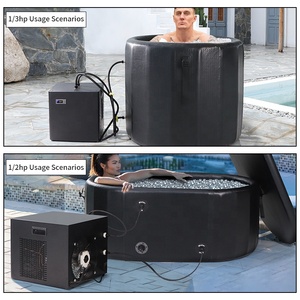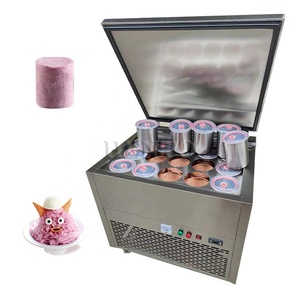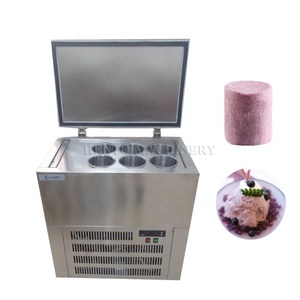(334 products available)






















































































































































































































































An ice-making machine prepares ice from water, whether in a residential, commercial, or industrial setting. An ice-making machine creates ice through an automated process that involves watering, freezing, and collecting the ice. Ice-making machines offer a quick and efficient way of producing ice on demand so that businesses, companies, and people do not have to rely on natural ice.
Flake Ice Maker Machine:
The flake ice maker machine produces ice in thin, flat sheets. It works by spraying water onto a cold surface or drum, where the water quickly freezes into thin ice layers. Heat exchangers in the machine help to separate the ice from the surface. The frozen ice layers are then crushed into flake-shaped pieces and collected. The drum-type ice maker machine is a common design used in the production of flake ice.
Cube Ice Maker Machine:
Similar to the flake ice maker, the cube ice maker has an automatic water feeding system. It produces crystal-clear ice cubes instead of cloudy ones. Advanced North American ice cube machines stick to this important feature, producing ice of a better quality that meets drinking water standards. The machine uses the Counter-Flow technology freezing process, which provides faster freezing times, increases water efficiency, and lowers energy consumption.
Crushed Ice Maker Machine:
The crushed ice maker machine combines ice cubes and small ice particles. It produces ice by rapidly chilling and freezing water, usually in a blast freezer or ice-making chamber. Some crushed ice maker machines have a built-in ice hopper that stores the ice until needed. Businesses place orders for large quantities of crushed ice maker machines because they produce a popular product that sells quickly and is often in demand.
Ice Machine Dispenser:
The ice machine dispenser offers a convenient way to store, dispense, and produce ice. It is often integrated into refrigerators, standalone units, or combined with water dispensers. The machine makes ice in cube, crushed, or flake forms. Users can dispense it directly into cups, containers, or bottles with the press of a button or lever, reducing the risk of unnecessary handling and contamination.
The Ice Making and Water Chiller plays an essential role in different industries highlighting various applications:
Food and Beverage Industry
This industry uses ice makers for both cooling products and preserving them. Ice makers help maintain products like soft drinks, juices, perishable foods, and frozen snacks at optimal temperatures to ensure freshness, extending shelf life, and preventing spoilage. Additionally, ice makers are essential for preparing frozen desserts like ice cream and sorbets.
Hospitality Industry
Hotels and resorts use ice makers to provide ice for their guests, be it straight ice, iced beverages, or refreshing drinks. Ice dispensers strategically placed throughout hotel facilities can enhance guests' experience, especially in hotels located in warm climates.
Catering and Events
Icemakers are essential equipment in the catering and events industry, especially for outdoor events. Ice keeps perishable foods and beverages properly chilled and at safe temperatures. Additionally, ice adds a touch of elegance to event presentations through creative ice sculptures, iced displays, and dessert stations.
Marine and Offshore Applications
Ice-making machines are used in maritime and offshore settings like commercial ships, drilling rigs, and remote islands. Marine ice makers create ice on board vessels. This is because traditional ice production methods and centralized refrigeration systems may be infeasible or costly in offshore and marine environments. Ice is crucial in marine settings to preserve food supplies, produce frozen products, and mitigate heat generated by equipment and machinery.
Medical and Healthcare Facilities
Hospitals, clinics, and healthcare centers need ice makers to provide ice for therapeutic purposes, such as cooling packs, compression wraps, and cooling blankets. Ice makers also help maintain medications and medical supplies that need refrigeration to ensure compliance with temperature-sensitive regulations and standards.
Supermarkets and Grocery Stores
Ice machines are widely used in grocery stores, beverage retail shops, and supermarkets. Products such as frozen seafood and frozen vegetables are kept chilled to maintain their quality. Additionally, ice dispensers are convenient for customers who want to purchase bags of ice for personal use, especially during holidays and special occasions.
Industrial and Manufacturing Ice Needs
Many manufacturers and industries are in constant need of ice, which is used to cool down hot equipment and machinery. Some also require ice to facilitate exothermic reactions. Specifically designed ice makers are used to produce large quantities of ice for industrial applications, usually in bulk or a continuous flow.
Ice making and water chillers are second only to the air conditioning industry in terms of significance.
Assess Cooling Capacity and Performance:
When choosing ice-making machines and water chillers, assessing the cooling capacity and performance is crucial. It is essential to choose machines that provide sufficient cooling capacity to meet specific demands. It may involve evaluating factors such as temperature requirements, volume, and distinct applications. Additionally, buyers should look at the efficiency and effectiveness of ice-making machines and chillers. Opting for machines with high energy efficiency can help save operational costs and minimize environmental impact.
Consider machine types and technologies:
Various ice-making machine types are available, including flake ice machines, nugget ice machines, and tube ice machines. Each type has its own advantages and is suitable for particular applications. Similarly, different water chillers are designed to suit specific needs. Buyers need to consider the features and benefits of each machine to choose the right one that fulfills particular requirements.
Evaluate product quality and reliability:
Product quality and reliability should be given priority when choosing ice-making machines and water chillers. It should be ensured that the selected equipment is manufactured according to stringent quality standards and are with well-known brands. Also, considering the after-sales support and maintenance services offered by suppliers is essential. This way, buyers can ensure their long-term operation and reliability of devices.
Check Energy Efficiency:
It's essential to evaluate the energy efficiency of ice-making machines and water chillers. Refrigeration equipment usually consumes a large amount of energy, and opting for high energy-efficient machines will help reduce energy consumption and operating costs.
Assess environmental impact:
When selecting ice-making machines and water chillers, considering the environmental impact is essential. Choosing equipment that uses environmentally friendly refrigerants and energy-saving technologies can help reduce carbon footprints and promote sustainable development.
Q1: What types of water chillers are there?
A1: There are different kinds of water chillers such as ice-water chillers, flavor-tube chillers, brine-water chillers, and evaporative cooler chillers. Ice-water chillers use ice to cool the water, while flavor tube coolers use narrow tubes to cool the liquid. Brine chillers use a mixture of water and salt to cool the water, while evaporative chillers use the evaporative cooling effect to cool the water.
Q2: What determines the size of an ice maker?
A2: The ice makers' capacity and dimensions are the main factors that determine their sizes. The capacity is the amount of ice the machine can produce in a 24-hour period, usually measured in pounds or kilograms. Common capacities range from small under-counter machines that produce around 25-100 pounds per day to larger commercial machines that can produce several hundred or even thousands of pounds per day.
Q3: Do ice makers use a lot of electricity?
A3: The power consumption of ice makers is generally in the range of 300-1000 watts, depending on the size and technology. Avoid leaving the door open for a long time to prevent unnecessary ice build-up and avoid running the ice maker at maximum capacity continuously unless high production is needed.